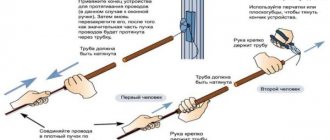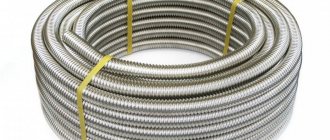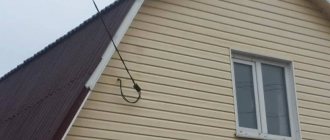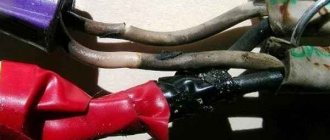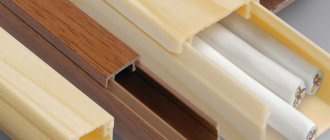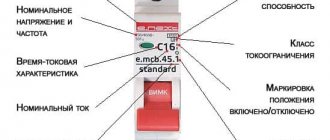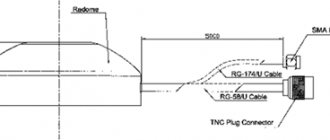In what cases is corrugation needed when laying cables?
Corrugation is a special pipe of a special shape, which is characterized by increased flexibility and can be made of polymer PVC plastic, polypropylene, polyethylene, polyamides or metal.
The main function of the corrugation is to provide protection for electrical wiring in a private house, apartment, or any other place where cable and wire products are installed from mechanical influences, the influence of precipitation, moisture, UV radiation and other negative factors. Having the ability to self-extinguish, the corrugation takes the first “blow” if the power line ignites.
Let's consider situations where the use of corrugated pipes is strictly regulated by regulations and is simply rational:
- installation of exposed electrical wiring indoors on non-flammable surfaces (concrete, brick, etc.). To lay cables on wooden planes, you will need a special substrate made of a material that does not ignite, or ordinary metal corrugation;
- laying cables in a hidden way in rooms, for example, in a concrete pour, is recommended to be supplemented with corrugated protection;
- installation of external electrical routes, including overhead ones. Important: you should choose a corrugated pipe that is not afraid of UV rays;
- laying unarmored cables in the ground. For these purposes, you will need stainless metal or HDPE corrugation;
- installation of electrical routes in areas with a high probability of causing damage to cable products;
- creation of moving parts of an electrical circuit;
- planning to replace the cable line in the future (to simplify installation, the corrugation can be taken a larger size).
Increased cost of work
Let's figure out whether corrugated installation really leads to a significant increase in the cost of repairs.
For ease of installation of electrical wiring, many use round NYM cable, including VVGng with a round cross-section. At the same time, they tighten it into the corrugation d=16mm.
After which you need to prepare a 20mm*20mm groove. If you have a wall chaser, the width of the groove when installing the disks does not particularly affect labor costs.
Many people initially set the cutting depth to 25mm to make it easier to cut the middle of the furrow. The shallower the cutting depth, the harder the core chips.
Therefore, in order to lay the bare cable in the groove, you will still have to cut a strip approximately 20mm deep. Or work very hard with a hammer drill, which will ultimately lead to no less labor costs. At the same time, do not forget one important nuance - gating in load-bearing walls in panel houses and hollow-core slabs is prohibited.
And where the cutout is not made in load-bearing walls, firstly, the integrity of the reinforcement should not be compromised, and secondly, the depth of the cutout should not exceed 20mm.
Therefore, when we talk about cutting a groove in a wall, in 90% of cases we mean cutting a groove in the plaster. The problem is that not everyone wants to apply 2.0-2.5 cm of mixture to the walls, just because of the wiring.
However, there is still an increase in cost when working with corrugation, and for many it can be critical. When working with this material you need:
special fasteners and nails. Using a mounting gun, on average it takes 3 shots per 1 meter of corrugation.
more junction boxes. If you use boxes with 4 separate inputs, then without corrugation you can place a much larger number of cables there. But when working with corrugation, there are only four!
Therefore, the total number of boxes, although not significant, will increase. It was already said above that the gating itself does not increase costs so significantly, but if we talk about drilling through holes through the walls, then everything can change significantly.
If you drill one hole d=32mm, you can easily pass 4 bare cable lines through it. But for the same quantity, but already in a corrugation, you will need to drill at least 4 holes.
When working in an apartment with soft partitions, this point is not critical. But if you try this in a private house, or in a panel high-rise building with high-quality concrete walls, your labor costs will increase many times over.
For many electricians working alone, it can take a whole day of work just to punch through holes. Therefore, yes, in some cases, depending on the working conditions and the specific object, the increase in the cost of laying cables in corrugated cables can be at least 30%. And for some, this is a significant difference in the total cost of repairs.
But can corrugation, on the contrary, help save a lot? Surprisingly yes. Here is a very original use of it for securing a cable in a groove. Thanks to it, you can completely eliminate the cost of dowel clamps. In this case, you can even use the remains of corrugated hoses, which are no longer needed anywhere.
Standards and rules for laying cables in corrugated cables
The requirements of state regulatory documents do not directly indicate the need to lay electrical cables in corrugation. However, from some standards one can draw clear conclusions about the use of corrugated pipes. For example:
- in table 2.1.3 PUE
(Fig. 1) it is recommended to install unprotected and protected cable and wire products in pipes made of difficult/non-combustible materials;
— clause 7.1.37 PUE
indicates that electrical wiring in the premises must be replaceable. It is easier to do this if the method of pulling the cable in a corrugation is used, because the procedure for replacing an electrical line that is laid in a groove or embedded is very labor-intensive;
— clause 3.58 SNiP 3.05.06-85
obliges to take measures to protect cable lines from mechanical damage.
Features and nuances of installing corrugated cables in the ground
Installation of cable and wire products in corrugated structures in the ground does not contradict the requirements of the PUE and profile SNiPs. It is important to choose the right material and diameter of the corrugated pipe, as well as take into account all the nuances of this part of the electrical installation work. Below is a list of features to consider:
- You should not use corrugation made of ordinary metal. It will quickly become unusable under the influence of corrosive forces (moisture, chemical compounds);
- Polymer PVC corrugation is a possible, but not ideal option. This material does not withstand temperature changes well enough, it can become brittle and begin to “crumble”;
- Corrugated HDPE is the best choice. Low-density polyethylene copes well with all the “challenges” of underground cable laying;
- it is necessary to take care of special protective cases that will be placed over the corrugation in rocky areas of the cable route, in areas with an increased likelihood of soil pushing and disruption of the integrity of the power line (roads and paths, near trees, in shallow trenches, near other pipelines). The cases are made from asbestos-cement pipes or modern plastic materials, including detachable ones in the form of a pair of half-cylinders;
- when laying the corrugation together with the cable, you must not pull it; there should be a slight slack or even a wavy laying;
- We must not forget about grounding the armor of protected cables and stretching the signal tape.
Hidden and open laying of wires in a corrugated pipe
Hidden electrical wiring in walls has its advantages, for example from an aesthetic point of view. In addition, the conductors are cooled better.
The disadvantages of this type of installation of power lines traditionally include:
- high labor intensity; — a large amount of construction waste; — increased likelihood of subsequent damage to the wires, for example, with a hammer drill; — a problem with installing hidden power lines in wooden buildings; — difficulty or impossibility of replacing electrical wires.
These problems are partially solved by pulling the cable into a corrugated cable and laying the pipe in prepared grooves or monolithic concrete.
It is easier to install open wiring in a corrugated pipe by making bends to lamps, sockets and switches. Flexible corrugation is excellent for laying even on uneven walls. The corrugated pipe is secured with special clips or ties.
Rules for installing corrugated cables in walls and ceilings
When laying corrugated cables along wall or ceiling surfaces, you must follow simple rules:
- cable power lines must be mounted in a horizontal or vertical plane;
- Mutual intersections of power lines should be avoided;
- power supply to switches is usually supplied from above, and to sockets from below;
- clips for mounting corrugations are secured using special anchors, screws or dowel nails;
- the distance between the corrugated pipe fastenings should not exceed 40 cm, otherwise the structure may sag;
- the joints of corrugated sections are formed by connecting couplings;
- the inter-wall passage of the corrugated route is made through a special sleeve and can be sealed;
- The rotation of the power line placed in a corrugated pipe is carried out to a radius the value of which is higher than permissible for the corresponding brand of cable product. It is important to remember that bends make future cable replacement more difficult;
- The corrugation must be secured to a suspended ceiling only on a concrete base.
Dowel clamps
The fastener is made in the form of a bracket, which can be used to press the wire by driving it into a pre-drilled hole. Dowel clamps are designed for fastening wires of a certain diameter. For example, in the assortment of our online store there are dowel clamps in black and white for cable diameters of 5-10 mm, 11-18 mm, 19-25 mm. The fasteners are made of durable polyamide. The hole diameter for all types of dowels is 6 mm. The disadvantages of such fasteners include low versatility - you need to select certain dowel clamps for different cable diameters.
How to quickly pull a cable into a corrugation? — Recommendations, video
In order to quickly pull wires into the corrugation, you will need a certain skill. This procedure itself is not difficult if you follow the instructions:
cut the corrugated pipe to the required length. Be careful not to damage the wire inside - it will be needed later;
twist the end of this wire (“conductor”) with the cable/wire;
insulate the joint for smoother pulling;
create tension in the corrugation, for example, by securing the second free end of the “conductor” to the door handle or battery;
pull so that the conductor gradually, without jerking or catching, enters the corrugation.
The entire algorithm for pulling the cable into the corrugation is clearly shown in the video.
Studying the box wiring diagram
When connecting wires in a junction box, it is very important to know the specific markings of each cable. This will create a secure, reliable and generally correct connection.
Let's study the wiring diagram of the box. Connecting wires with grounding (PE)
Connecting wires without grounding (PE)
So, the “zero” wires (in the diagram they are blue) and the ground cables (indicated in yellow) are connected accordingly by color, as shown in the image. When arranging two-wire wiring, the circuit remains the same, only the grounding wires are excluded.
The phase desoldering procedure (indicated in black or red) is more complex. If only cables are routed through the box to connect the socket, the phase wires are also connected together.
Scheme in a junction box, two lamps
If cables go from the box to a switch with one button, then the wire that goes to the switch must be twisted with all the wires of the phase. The same cable that comes from the switch is connected to the phase wire going to the lighting fixture. As a result, 4 connections will be made.
Scheme in a junction box, two lamps and a group of sockets
In the case of connection through a junction box of a switch with two keys in conditions of three-wire wiring, a cable with four cores is connected to the chandelier. If the wiring is two-wire, the number of wires is reduced to three, because grounding is excluded from the circuit, as shown in the figure.
Studying the box wiring diagram
Without taking into account the separate twisting of the ground electrode, 4 connections are created in the box. All the “zero” wires (indicated in blue) are connected to each other.
The phases of the sockets and the power cable are twisted together and then connected to the common terminal of the switch with two keys. From the latter there are 2 separate wires going to the lighting fixture.
Thus, there is nothing super complicated about wiring the box. You just need to understand the peculiarities of the wire designation and the order of their connection. After this, you can begin to consolidate the acquired theoretical knowledge in practice.
Proper connection of wires in the junction box
Prices for distribution boxes
Distribution boxes
Is it possible to lay wiring without corrugation?
For every property owner, sooner or later there comes a time when he needs to decide which electrical wiring will be most optimal in his building. Someone decides to spend an unreasonably large amount of money on installing cables in a corrugated pipe, thereby enriching the contractor. Some people, in order to save money, decide to ignore regulations, putting people’s lives in danger, and install electrical wiring without corrugation. Let's try to understand all the nuances and find out: what kind of wiring should be in the room and how to make it safe without spending extra money.
- Is corrugation necessary?
- Cases of justified use of corrugation
- Cable laying without corrugation
- Open installation method
- Hidden electrical wiring in the walls
- Conclusion
Cases of justified use of corrugation
In places where the wiring may be subject to mechanical damage, the cable is installed in a corrugated pipe.
It is used practically without restrictions in low-current systems:
- in signaling,
- in cable television,
- in telephone lines,
- on the Internet.
You should not do without corrugation when laying cables in a floor screed.
If the supply lines are placed under plasterboard or suspended ceilings, then it is more convenient to use a corrugated pipe. Then the wiring changeability requirement given in Chapter 7.1 will be met. clause 7.1.37. PUE, and additional mechanical protection of the power line will be provided.
Fastening metal trays
Metal trays are not used in residential premises. They are used in areas where there are several large diameter cables that require mechanical protection. For example, in production, where machines are concentrated, as well as when laying cables outdoors.
There are several options for attaching metal trays:
- dowel-nails, screws or bolted connections to partitions during installation using various accessories;
- dowel-nails or screws directly to the wall. Metal trays have many accessories for interconnecting and routing at different angles.
Cable laying without corrugation
Electrical wiring in a home can be installed in several ways, depending on:
- cable type;
- the environment in which the wiring is planned;
- base material on which installation work will be carried out.
Cable laying without corrugation can be done in an open or hidden way.
Open installation method
When installing power cables on combustible structures or in places where it is difficult to make grooves, open wiring is used. It is laid over the walls and along the ceiling with a finished finish.
Fastening is carried out with brackets (clamps) at least every 40-50 cm, and in places of bending, 10 cm on each side of the bending point. The fastening frequency should be such that the cable does not sag.
This installation method is used mainly in basements, utility rooms, and garages. It is also possible to install wiring in residential premises on walls and ceilings without corrugation, if the cable has a fireproof sheath.
Open wiring in retro style in wooden houses is performed with single-core conductors twisted together, attached to the surface of the walls (ceilings) using porcelain insulators. There may be two or three wires, depending on whether there is grounding in the house.
In the manufacture of modern retro cables, copper wires with a cross-section of 0.75-2.5 square meters are used. mm. First, they are covered with a layer of PVC, after which there is decorative insulation made of silk impregnated with a composition that does not support combustion. Fiberglass covering may be used.
Installation in a metal pipe is one of the most labor-intensive, expensive and at the same time reliable methods of open wiring. Most often used:
- in fire and explosive areas;
- when passing through ceilings and walls;
- for inputs into cable kiosks;
- for outdoor installation;
- in wooden houses, baths, etc.
Metal pipes reliably protect communication networks from mechanical damage and aggressive environments. In addition, open wiring in metal pipes can be an interesting design solution when decorating a room.
Hidden electrical wiring in the walls
To give the room the most aesthetic appearance, hidden electrical wiring is used. The cables are hidden in the wall (ceiling) material, hidden under a layer of plaster.
The cable is laid in grooves - specially cut grooves, the width of which must correspond to the thickness of the conductor. Obviously, it is better to do without corrugation here, since making furrows for it is much more difficult.
It is more convenient to install electricity before finishing work, then you can do without gating. First, the wires are fixed, and then the walls are plastered.
Before installation work, markings are made for the future electrical system of the apartment. Mark the installation locations of sockets, switches, junction boxes, and wiring lines.
Then they start cutting the grooves. To do this, you can use a hammer drill, wall chaser, grinder with a diamond blade, or impact drill.
After the places for sockets, switches, junction boxes and grooves for laying cables are ready, installation of the electrical network begins.
Methods for securing wiring in grooves
There are a huge number of variations in securing the cable in the groove. We will look at the main ones:
- Perforated strip. This type of nylon strips was in demand during the construction of the well-known Khrushchev-type houses. These strips were fixed across the groove with dowels, firmly holding a large number of wires.
- Aluminum mounting strip. This product is present on the shelves of any hardware store or in electrical goods. However, if you wish, you can make the strip yourself. To do this, you need to cut plastic metal strips. During the installation process, it is necessary to punch the strip in the center and secure it in the groove using a self-tapping dowel. Then lay the cable on top of the strip and bend the ends of the product. The result will be a design similar to a tight, reliable lock. This method requires a lot of effort, but is often used by construction professionals.
- Securing the wiring in the groove with alabaster. Here it is necessary to lay the wires, immediately fixing them with an alabaster solution, covering with a spatula the places where the cable is laid with an interval of about 30 cm. The disadvantage of this method is the fact that alabaster can dry out quickly and it is impossible to dilute a large amount of its solution.
- The most popular method of securing the wire is a dowel clamp. These are dowels measuring 6 mm. The end of the product is presented in the form of a loop that holds the wires. Therefore, this fastening process is the simplest and accessible even to an inexperienced builder. Here you need to make a certain number of holes using a hammer drill and a 6mm diameter drill, then install a dowel-clamp with the wires already fixed in it.
You can watch a very interesting way to secure a wire in a groove video here:
How to lay the cable
We firmly believe: the PUE was written by sensible people. They are well familiar with Russian realities, they left few loopholes in the theses, and closed those contained in other documents. Switchboards cannot be installed in bathrooms. Obvious fact? Find information in standards and building regulations. It turns out that an apartment switchboard can be installed in zone 3 (classification GOST 50571.11). Let's start the search by examining PUE 6, although the collection of rules is completely deprived of legal force.
It’s not the law that’s important; we want to build a house. We begin the classification of the installation method by determining whether the wiring is hidden or open. It's easy to distinguish. Hidden electrical wiring is hidden by elements that are a structural part of buildings. If you put the corrugation in plain sight, there will be exposed electrical wiring. Although the insulation of the wire is not visible, no one outside will be able to tell what is inside. A similar corrugation will take on a different meaning when laid under the floor. Hidden electrical wiring.
Hidden point: PUE operate with the concept of a protected wire. There are references to GOST, we know (we saw it on the Internet), the definitions are misinterpreted. One forum provides a link to the GOST 15845 standard. Complaints follow, saying that it is not clear how open cable laying along the wall is carried out, the distinction is made on the basis of security. There is no such thing among the definitions. Each cable and wire is equipped with GOST, TU, act according to the text.
SIP refers to GOST R 52373. The standard indicates: protected wire. What and how is the tenth question. The PUE follows the vocabulary, referring to GOST. SIP installation is carried out like a protected wire. We emphasize again - the term defines the structure of the cable, alien to boxes, sleeves (corrugations).
Lay corrugation along the wall and floor
Many people are probably interested in how corrugated pipes are connected to distribution boxes. We weren’t going to get away with general phrases, listen!
- Individual pieces of corrugation are joined using couplings (price is about three rubles per piece). Use the products offered by the manufacturer. There are many ways to connect the coupling and corrugation. If there are no cable connections in a given area of the site, it is possible to seal the joints with sealant.
- There is a steel broach inside the expensive corrugated models. Pipes for laying wiring in the apartment are used as efficiently as possible: a channel is made in the wall (on the surface), and according to the electrical diagram, the required number of wires is pulled inside.
- The corrugation is attached to the wall with specially shaped anchors. Installation on brackets made of metal packaging tape, which is pressed onto dowel-nails, is allowed.
- As for the accumulation of water inside the corrugation, the forums are full of the topic. The legislative part of PUE 6, which we are considering today, has not been adopted. If you are building for yourself, it is more important to feel confident in the quality than to comply with the letter of the law. In dry rooms, it is allowed to use corrugated joints without compaction or sealing.
- The cable is laid through a corrugated wall through a special sleeve, selected in diameter. The passage is sealed if necessary.
- The turn is performed by bending the route with a radius higher than that allowed for the bundle cable brands. Similar parameters are often indicated for corrugation. Please note that if it is necessary to replace part of the cores, problems may arise. When rounding the corrugation, be careful not to bend it. Otherwise, the requirement for filling the section (35%) will be violated.
- In the attic, the height of the cable on the wall is not standardized when using any corrugation. However, the requirements listed above are met.
Indoors, it is practiced to lay cable ducts along the walls, because the technique looks elegant. And in basements and attics, corrugation is appropriate due to its excellent insulating properties.
Cable ties for dowels
A nylon tie at the base with a hole for fastening. Installation is simple. A hole is drilled to match the diameter of the fastener. The holes of the cable tie and the base are aligned, after which the fastener is driven into them. The screed is distinguished by its versatility, since the base can be almost any material - concrete, brick, stone, wood, plastic. Accordingly, both dowel-nails and self-tapping screws, screws, nails, screws can act as fasteners
Is corrugation needed when laying cables?
Some people confuse the concepts of wire and cable. Let's first take a moment to clarify this issue. A wire is a core with insulation, and a cable is several such wires with additional insulation. Many people ask whether corrugation is needed when laying cables? The answer to this question is given by the PUE.
The PUE has its own requirements for both cable and wire. It is logical to conclude that the requirements for a conductor with additional insulation should be softer and in most cases, it does not need corrugation. On the contrary, the installation of wires must be approached more seriously. Here corrugation is almost mandatory. In this article we will take a closer look at the moments when laying a cable in a corrugated cable is necessary and when it is not.
Welding wires
Wire welding involves welding the ends of the wires using a special machine. At the end of the twist, a drop of welded wires is obtained. At the welding site, the twist is a single whole and the wires in this place do not oxidize.
The connection is high quality and durable. The disadvantages are that to produce high-quality welding, special equipment is required (special welding machine), work skills are required, labor intensity, and permanent connections.
You can also use an inverter welding machine for welding, but then the welding turns out to be fragile, since the welding voltage is 40-90 volts. Whereas for welding wires it is best to use a machine with an output voltage of 12-36 volts.
Expert opinion
It-Technology, Electrical power and electronics specialist
Ask questions to the “Specialist for modernization of energy generation systems”
Advantages and disadvantages of installation without distribution boxes In this case, if the sockets are spaced far enough from each other and we feel sorry for the cable, we make two distribution boxes. Ask, I'm in touch!
In what cases is corrugation needed and in what cases is it not?
If you plan to use a cable with fire protection (for example, VVGng-LS 3x1.5 flat), then in most cases corrugation is not needed. However, there are exceptions. If the conductor needs to be laid in the ground or there is a possibility of damage, then corrugation is required. For example, when pouring a concrete screed, or when it is planned to replace it in the future. Just note that in this situation, PVC corrugation will not work. The metal version in this case will be more appropriate. There are no restrictions on the use of a protective tube when laying telephone lines, Internet lines, etc. Laying several cables in one corrugation according to the rules of the Electrical Installation Code is allowed, in particular, group lighting lines and sockets. However, it is worth remembering that if a failed conductor is replaced, this task can become difficult and unsafe.
When installing internal wiring (not cable), corrugation is required. In such cases, the cable can be placed in a corrugation if there is a possibility of its replacement. However, such a conductor must be flexible and the protective tube is selected 1 size larger. The PUE states that when installing power cables in frame or wooden structures, the use of corrugation is strictly prohibited. Also, if the cable is planned to be laid in a wall, under the floor or baseboard, there is no need to use corrugation. According to the PUE, the requirements for the corrugation are much stricter than for the cable itself. For internal wiring, there must be at least 10 cm of plaster or other fireproof material around such a protective tube. There are no such conditions for cable installation.
When is corrugation used?
Firstly, the corrugation will allow the cable to be laid inside structures. According to the rules, if the building material is combustible, it is necessary to fence off hidden wiring. The role will be played, for example, by aluminum corrugation. Next, select the text relevant to the situation:
Shared lines
In mechanically strong hoses it is allowed to lay together lines for the following purposes:
- Power circuits of one unit.
- Power and control circuits of technologically interconnected equipment.
- A circuit that powers complex lamps (a chandelier with two keys).
- Single-purpose lighting lines (emergency, main), provided that the number of wires is less than 8. The total cross-section, including insulation, does not exceed 35% of the internal diameter of the corrugation. Wiring replaceability and maintainability are ensured. The corrugations go between the distribution boxes. The connection points are accessible to visitors. Corrugated is unable to provide opportunities.
Corrugation, tubes
- Lighting circuits up to and above 42 volts, which are prohibited from being laid together. The low-voltage part is additionally insulated with a pipe. Circuits up to and above 42 volts may be laid in one sleeve, provided there is a partition with a fire resistance of at least 0.25 hours (15 minutes).
Cross-section of conductor and ground electrode
The smallest conductor cross-section is selected according to table 2.1.1 PUE 6 (https://files.stroyinf.ru/Data1/42/42611/index.htm#i42831785). The diameter of the core depends on the purpose of the wire.
Grounding conductors, regardless of the installation location, provide a certain minimum cross-section. For a rectangular shape, 48 square millimeters in steel with a thickness of at least 4 mm. Round potential equalization lines can be made using wire rod with a diameter greater than 6 mm. The minimum cross-sections of aluminum, copper zero-working, grounding conductors are, respectively, 2.5, 1 square millimeter. For individual insulated wires, the parameters are 2.5 and 1.5, for non-insulated wires - 6 and 4. Let us recall that the cross-section for copper and aluminum of the main grounding line going to the circuit is 6, 10 square millimeters.
One channel - several wires
It is prohibited to lay main and backup cable lines, working and emergency lighting cores in one channel. The phase and neutral working wires are laid in one pipe.
Forming connections
Electrical connections of wires are formed through terminal blocks, soldering, welding, and crimping. Note that twists do not appear. The laying of corrugated pipes in the walls is designed to ensure the replaceability of wiring. Wire connections are available for inspection and repair. Use junction boxes.
Corrugation plexus
Combustible and non-combustible base
A fireproof corrugation is laid along the combustible base in the form of open wiring. Concealed installation in a groove (cutout) is allowed. The corrugation is fireproof, or a gasket is installed to separate it from the base. The top can be sealed with plaster.
Plastic corrugation can be placed in the grooves of concrete and brick walls to form channels (needed to change electrical wiring). With subsequent finishing with plaster and other fireproof materials. If necessary, if you want to use lining, read above - lay it with fireproof material. To avoid breaking your brain, use Penofol. Easily withstands the pressure of a gas burner. External laying of the cable along the walls in plastic corrugation on fireproof bases is allowed.
When laying corrugation along a fireproof wall along the route, it must be at least 10 cm away from combustible areas. If they are unable to provide this, use a separating layer at least 10 mm thick: plaster, alabaster, cement.
Protective functions
The metal corrugation is connected to the building's potential equalization system, which goes to the grounding circuit of the lightning rod. At the same time, the step will provide protection against radiation outside the 50 Hz industrial frequency.
The metal corrugation is protected against corrosion according to environmental conditions.
The corrugation is laid to avoid moisture accumulation. The housings of distribution boxes and panels are equipped with cable entries. Conical ones are equipped with expanding sectors. The diameter increases starting from the top. By trimming, we achieve the desired size. The junction of the corrugation and the junction box is impermeable to moisture. If necessary, add adhesive sealant around the cut perimeter.
Posting planning
Using this method, power cables are laid along the walls of buildings from the outside, from the inside. If the requirement is ignored, a small amount of liquid may cause the system to fail. Applies to communication systems where signals are weak. If you take power wires, liquid entering a phase will certainly cause a complete failure of the line.
Note that the broken corrugation needs to be repaired. Hooligans have many opportunities to ruin an electrician's life. How to repair? The plastic one can be sealed (if you have the skills) with polyethylene, the metal one can be sealed with a special acid. Increased attention is paid to rooms with high steam levels.
Metal corrugation
It is sometimes prohibited to use metal corrugation. In bathrooms and toilets, the use of metal corrugation is limited. It is allowed to be placed under the floor surface, covered with a grounding mesh. Applies to metal screens and cable armor.
In other places the aluminum corrugation is grounded. The resistance up to the bus output point does not exceed 10 ohms. It is measured by a tester (if you have the skills) or a special device.
Open wiring
When laying open, the distance from the corrugation to the combustible base is 10 mm. If the condition cannot be met, re-use gaskets (for example, Penofol). Should protrude 10 mm away from the corrugation border.
According to the regulations, unprotected open wiring is carried out at a height of at least two meters from the floor (surface, ground). The condition can be radically changed by using corrugation with a degree of protection of at least IP20 (against penetrating objects with a diameter of more than 12.5 mm). You don't have to choose. Any corrugation fits the definition. Of course, at the same time we will fulfill the requirements according to which the cable is laid along the wall of the building.
Laying open wiring on roofs is prohibited. With the exception of building entry points.
Corrugation for laying cables in the ground
During installation work on laying cables in the ground, protective cases are used, such as a metal hose or HDPE corrugation. The latest version of the tube has the following properties:
- elasticity;
- high strength;
- the ability to restore its original size.
Using this method of laying, when compared with external laying, has enormous advantages, namely:
- weather protection;
- mechanical;
- chemical
Metal corrugation is also suitable for these purposes, but its price will be approximately 2 times higher. But the service life of such a metal hose will be longer.
Corrugation for underground cable installation should not have magnetic properties. It is worth knowing that the diameter of the protective tube directly depends on the length of the cable. So, for example, if the conductor is up to 5 meters, then it can be placed in a 50mm corrugation. If the length is more than 5 meters, then the protective tube must be at least 100mm in diameter. We draw the attention of interested parties that HDPE corrugated cable in Moscow costs between 7-36 rubles per meter, depending on its diameter.
Marking procedure
It is necessary to prepare grooves for wire lines in advance, and not at the time of the final finishing work in the house. The work is carried out when things, furniture, wallpaper, flooring are still missing. The best option for starting gating is a room with bare walls.
The first step is to determine and mark the paths for the conductors. Marking is done using construction pencils and levels. It is worth noting that the wiring should not be located haphazardly. It must be laid in a horizontal strip at a height of 2.5 m or vertically along a plumb line.
In addition, you need to decide on the depth of the groove. If the diameter of the wire or cable is large, then the groove should be 1.5 cm deeper than the diameter of the conductor. The same applies to the case if you decide to lay a pipe in a groove into which the wire will subsequently be pulled. We should immediately decide where the sockets, switches, and distribution boxes will be located, because these works are carried out at the same time as grooves for laying wires in pipes or hidden types. Depending on the number of wires in the harness that needs to be hidden, the width of the groove is also selected.
Corrugation for external cable laying
To lay the power cable outside, the following types of protective pipes will be appropriate:
- HDPE;
- polypropylene;
- metal hose
Let's look at them in a little more detail. The first option is the cheapest of the above. Resistant to sun and low temperatures. The next corrugation for outdoor cable laying costs about 2 times more than the first, but its use is possible in small areas from the equipment to the highway. The latter option has a long service life. Also well suited for laying near the ground, where there is a risk of cable damage by rodents.

